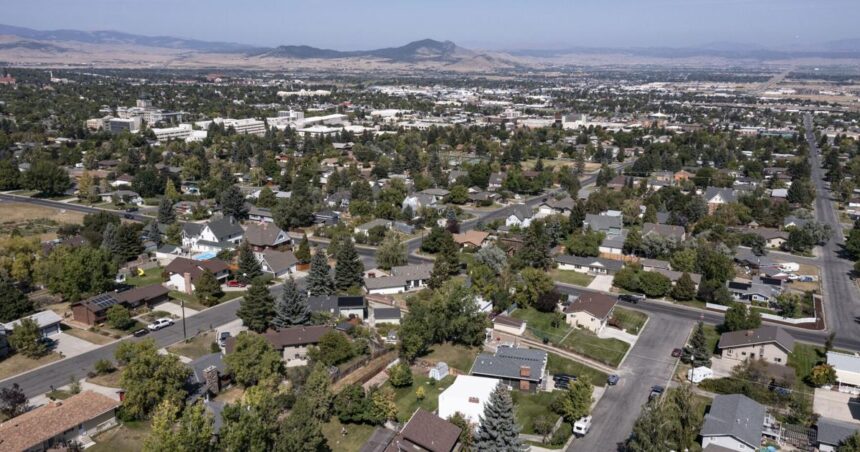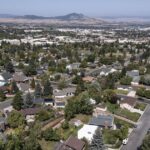The upcoming legislative session will see a flood of proposals aimed at addressing a surge in property taxes. As the property tax task force led by Republican Gov. Greg Gianforte finalized its recommendations this week, Democratic lawmakers have put forward their own plans, and the governor’s challenger in the fall election has presented his own ideas.
Over the past two years, Montanans have experienced a significant increase in the assessed value of their homes, resulting in a corresponding spike in property taxes, averaging a statewide jump of 21%.
This has sparked outcry across Montana, with a call for solutions from legislators in the upcoming January session. There has been finger-pointing as Gianforte attributed the issue to local county budgets, while commissioners pushed back, citing limitations imposed by the state on their levying powers. Minority Democrats have criticized majority Republicans for failing to pass meaningful legislation, and Ryan Busse, the Democratic gubernatorial candidate, has blamed Republicans for not passing a bill to adjust property tax rates for different property classes.
People are also reading…
During the final meeting of his property tax task force on Thursday, Gianforte expressed his support for one of the proposals put forth by the group—a homestead and “comstead” exemption aimed at reducing the tax burden for primary residences, long-term rentals, and small commercial taxpayers. However, this would mean an increase in taxes for non-primary residences, short-term rentals like Airbnbs, and larger commercial properties. This meeting coincided with the opening day for Montana homeowners to apply for property tax rebates introduced in the previous legislative session.
State Rep. Llew Jones, who chaired the task force subcommittee responsible for the proposal, mentioned that the idea could lower taxes for affected properties by 15-20%, benefiting around 215,000 primary residences, 130,000 long-term rentals, and about 32,000 small businesses.
The proposal aims to ensure that individuals who are not full-time residents of Montana but utilize public services and infrastructure in the state contribute to providing those services.
Gianforte voiced his support for the proposal, emphasizing the importance of the homestead exemption in maintaining the preference for Montana residents and their primary homes, while ensuring that out-of-state property owners pay their fair share for essential services.
In a dissenting perspective on the proposal, task force member Jeremy Horpedahl highlighted the potential increases in taxes for owners of second homes, short-term rentals, and large commercial properties. The report suggested that taxes for these properties could rise by 25-45%. Additionally, adjustments in property type mixes within a taxation jurisdiction could result in higher taxes for other property classes to compensate for revenue needs.
The task force introduced several other proposals that would require approval in the upcoming legislative session starting in January.
In the education sector, State Rep. David Bedey presented a proposal to shift school levies from district-wide to countywide, ensuring equitable funding distribution among all districts in a county.
Another proposal highlighted by state Sen. Greg Hertz focused on restricting local mill levy elections to dollar amounts rather than mill amounts. This approach aims to maintain revenue stability by adjusting mills to offset changes in taxable property values.
The Democrats’ plan
Earlier this summer, minority Montana Democrats unveiled a series of property tax proposals totaling $230 million in tax reductions. They emphasized that their plan targets lower and middle-income Montanans compared to the governor’s proposals.
The Democratic version of a homestead exemption includes exempting the first $50,000 in home value and $200,000 for small businesses.
The Democrats also proposed reforms in how the state calculates taxes on residential properties, suggesting higher tax rates for more valuable properties.
Senate Minority Leader Pat Flowers outlined a housing fairness tax credit aimed at individuals facing rapid increases in property values and taxes relative to their incomes, including renters.
State Rep. Jonathan Karlen provided examples of how the tax credit would benefit families, emphasizing the importance of complementary measures such as the homestead exemption and fair tax rates.
Flowers assured that the Democrats’ proposal would have minimal impact on counties and schools, with costs covered by a projected surplus in the upcoming legislative session.
Democrats have already submitted bill draft requests for their proposals.
The challenger’s idea
Democratic gubernatorial candidate Ryan Busse proposed reducing the residential property tax rate from 1.35% to 0.94%, presenting it as a straightforward solution overlooked by Gianforte and legislative Republicans in the previous session.
Former Governor Brian Schweitzer criticized the lack of rate adjustment, noting significant tax breaks for companies like NorthWestern Energy and Burlington Northern Santa Fe railway.
Busse’s plan primarily focuses on adjusting property class rates, with room for considering additional viable options if elected.
Busse highlighted the successful rate reductions under past administrations, countering Republican arguments about the complexities of adjusting rates due to changes in the property mix and potential impacts on specific sectors.
Busse’s running mate, Raph Graybill, dismissed arguments against rate adjustments, emphasizing the efficacy of the rates following previous adjustments.
Schweitzer critiqued another task force proposal requiring a 60% approval for new voter-funded levies, branding it as anti-local control.
Busse echoed concerns about the proposal’s implications on local governance and voter influence in budget decisions.





